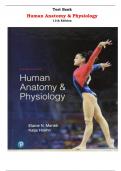Exam (elaborations)
Human Anatomy & Physiology 11th Edition Test Bank By Elaine N. Marieb and Katja Hoehn | All Chapter, Latest-2024|
- Course
- Institution
- Book
Human Anatomy & Physiology 11th Edition Test Bank By Elaine N. Marieb and Katja Hoehn | All Chapter, Latest-2024|
[Show more]



